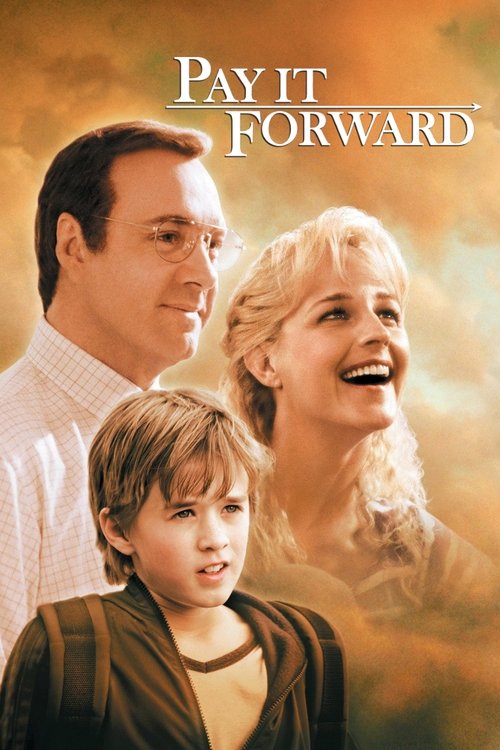
Title: Pay It Forward
Year: 2000
Director: Mimi Leder
Writer: Leslie Dixon
Cast: Kevin Spacey (Eugene Simonet),
Helen Hunt (Arlene McKinney),
Angie Dickinson (Grace),
Haley Joel Osment (Trevor McKinney),
Jay Mohr (Chris Chandler),
Runtime: 122 min.
Synopsis: Like some other kids, 12-year-old Trevor McKinney believed in the goodness of human nature. Like many other kids, he was determined to change the world for the better. Unlike most other kids, he succeeded.
Rating: 7.354/10
Ripples of Idealism: The Fragile Hope of Pay It Forward
/10
Posted on July 22, 2025
In Pay It Forward (2000), directed by Mimi Leder, the audacious premise of a child’s altruistic vision challenges the viewer to confront the tension between idealism and human frailty. The screenplay, adapted by Leslie Dixon from Catherine Ryan Hyde’s novel, hinges on young Trevor McKinney’s (Haley Joel Osment) social experiment: perform a significant act of kindness for three people, who must then “pay it forward” to others. This chain-reaction concept is both the film’s greatest strength and its Achilles’ heel, teetering between inspiration and oversimplification. Leder’s direction, earnest and unadorned, leans heavily on emotional authenticity, but the narrative occasionally stumbles into melodrama, undermining its own ambitions.
Osment’s performance is the film’s heartbeat. His portrayal of Trevor radiates a precocious sincerity that avoids cloying sentimentality, grounding the story’s utopian aspirations. His wide-eyed conviction contrasts sharply with Kevin Spacey’s restrained, almost brittle depiction of Eugene Simonet, Trevor’s scarred teacher. Spacey imbues Eugene with a quiet dignity, his guarded vulnerability a counterpoint to the film’s bolder emotional strokes. Helen Hunt, as Trevor’s struggling mother, delivers a raw, if uneven, performance, her character’s arc sometimes lost in the script’s broader didactic sweep.
Cinematographer Oliver Stapleton crafts a visual language that mirrors the story’s emotional terrain. Las Vegas, with its stark deserts and neon excess, becomes a metaphor for the characters’ inner desolation and fleeting hope. The muted color palette in intimate scenes contrasts with the garish cityscapes, subtly underscoring the tension between personal transformation and societal inertia. Thomas Newman’s score, delicate yet insistent, weaves a thread of quiet optimism, though its repetitive motifs occasionally feel manipulative, nudging the audience toward tears rather than earning them organically.
The screenplay’s ambition to tackle systemic issues poverty, addiction, and broken families through Trevor’s experiment is admirable but falters in execution. The narrative’s reliance on coincidental connections strains credibility, and its resolution feels too tidy, sidestepping the messier realities of human behavior. Yet, the film’s refusal to shy away from tragedy lends it a bittersweet gravitas, reminding us that even flawed gestures of kindness can ripple outward. Pay It Forward dares to imagine a world remade by compassion, but its idealism, while stirring, sometimes overshadows the nuanced human struggles it seeks to portray.
0
0
